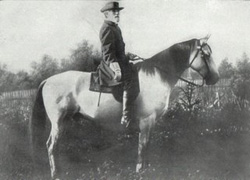 I recently stumbled across a great made-for-TV documentary series called Horses of Gettysburg
I recently stumbled across a great made-for-TV documentary series called Horses of Gettysburg. It first aired on PBS in June 2007, but if you, like me, missed it, you can watch all 12 installments on youtube or purchase the DVD. Filmed in high-definition with period photographs and battlefield re-enactments, it tells the story of the estimated 72,000 horses and mules that were used during the Battle of Gettysburg.
The series is packed with interesting details and insights, including the theory that Confederates were able to hold an advantage over Northerners in the first years of the war because Southerners were urged to use personal mounts, who were already attuned to their masters.
Owing to the difficulty, before mechanization, of supplying an army in the field, most battles lasted a day or less. But the Battle of Gettysburg lasted three days, during which time 3.5 million pounds of oats and 4 million pounds of hay were consumed by animals on both sides.
The installment “Maintaining an Army of Horses” describes methods used by both Union and Confederate Armies to keep their horses and mules healthy and productive. Another installment details Union guidelines for purchasing and training horses. For instance, they preferred animals between five and seven years of age and 15 to 17 hands in height.
As a result of high casualties – an estimated 5,000 horses and mules were killed at Gettysburg, alone – horses were in high demand during the war. Between 1863 and 1864, 118,000 were purchased for service by the Union Army and “horse traders” made an art of deceiving government agents about the age, condition and suitability of animals. There is also an entire installment devoted to “The Army Mule,” which was vital for delivering heavy loads, guns and ammunition.
Horses of Gettysburg concludes with a beautifully filmed and stirring segment called “The Great Equestrian Statues.” While there are more than 1,400 monuments, markers and memorials in Gettysburg National Military Park, the most magnificent ones honor officers, who are portrayed mounted on horseback, including General George G. Meade on Old Baldy and General Robert E. Lee on Traveller, the beloved “Confederate” grey gelding that served as Lee’s personal mount following the war and who was led behind the General’s hearse in 1870.
This is a wonderful series. Check it out here.
